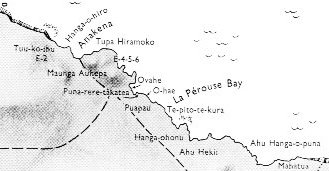5. The basic problem the creator of the G calendar had to solve was probably how to integrate a Sun year in a longer lunar calendar. I suggest his solution was a model where the mythical 'sea journey', between the end of one year (land) and the next was used. In Manuscript E we can read that the hulls of the double-canoe were untied from each other when the new land was in front: ... The two hulls were no longer kept lashed together (i.e., they were separated for the rest of the journey). Hotu called out to the canoe of the queen: 'Steer the canoe to the left side when you sail in. Teke will jump over on board (your) canoe to work his mana when you sail through the fishing grounds!' Teke jumped on board the second canoe, (that) of the queen. The king's canoe sailed to the right, the queen's to the left. Honga worked his mana in the fishing grounds. (List of five fishing grounds that belong to Hotu and Honga.) Teke worked his mana in the fishing grounds to the left side. (List of nine fishing grounds that belong to Hotu and Teke.) The men on board the royal canoe looked out from Varinga Te Toremo (the northeastern cape of the Poike peninsula). Then they saw the canoe of the queen, the canoe of Ava Rei Pua, as it reached Papa Te Kena (on the northern shore, east of Hanga Oteo). Honga came and gazed in the direction below (i.e., toward the west). He called out to the noteworthy ruler (? ariki motongi) Hotu: 'There is the canoe of the queen! It will be the first one to land!' At this news King Hotu replied to Honga, 'Recite (rutu) ('powerful incantations') as though the ten brothers of the chief (ariki maahu) were one whole (?).' The ten recited with all their might. This is what they recited: 'Let all movement (? konekone) cease!' They recited and sailed on swiftly: Honga, Te Kena, Nuku Kehu, Nga Vavai, Oti, Tive (corrected for 'Sive'), Ngehu, Hatu, Tuki, and Pu (corrected for 'Bu'). He worked mana in the fishing grounds. (Naming of two fishing grounds.) ... The pair of hulls could represent the time according to Sun respectively the time according to Moon. When the Moon Queen threatened to come first to the new land it could be because night number 354 ends 12 lunar months before the year is finished. Moon time must therefore stand still for a while, because the canoe of the queen had reached Papa Te Kena, a place name which ought to confirm of my idea. Papa means something flat and motionless (i.e. dead):
Te Kena is presumably the same bird as in Ana-kena, the place (star pillar) where the new Sun child (Tuu Maheke) and the new Moon child (Ava Rei Pua Poki) will begin their life journeys together (cfr Makoi's List Of Place Names):
|
